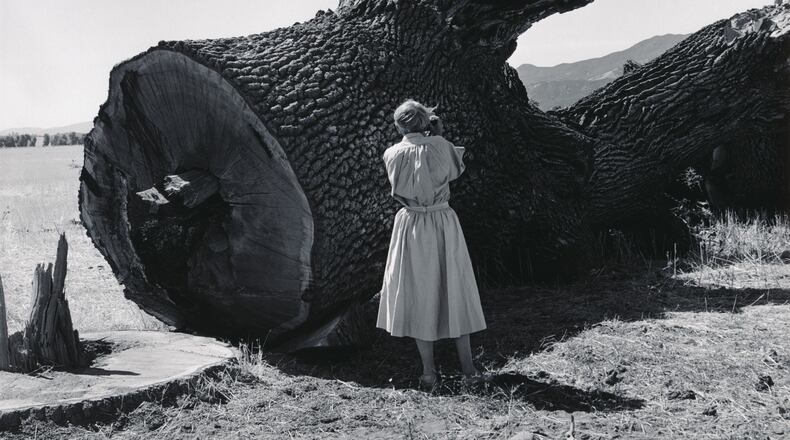In his 1974 film “Chinatown” about the battle for water rights in Los Angeles, Roman Polanski offered a film noir look at corruption and malfeasance. His grim tale was inspired by the real-life California water wars where that precious natural resource was diverted from rural lands to booming L.A. through the machinations of politicians and businessmen.
But “Chinatown” is just one version of how the fight to control water has imprinted California’s history according to a new exhibition at the Booth Western Art Museum in Cartersville.
A bracingly realist, clear-eyed vision of how California’s thirst for water has created real-life hardships unfolds in the fascinating photography exhibition “Dorothea Lange and Pirkle Jones: Death of a Valley.” The series was commissioned by Life magazine and executed by renowned photographer Lange, most famous for her 1936 image “Migrant Mother” of a mother and three small children that epitomized the hardships of the Great Depression.
Credit: Dorothea Lange
Credit: Dorothea Lange
For “Death of a Valley” Lange worked alongside Ansel Adams assistant and documentary photographer Pirkle Jones. When “Death of a Valley” was completed in 1956 “Life” magazine passed on publishing the series, perhaps because of how fundamentally it undercut the myth of America as a land of opportunity.
The story of the death of the productive, verdant, blissful town of Monticello, California, is told in 80 images and accompanying documents that picture the local general store, tow-headed children and their ever-present dog companions and bountiful harvests of grain, grapes and pears. The photographers document a kind of American Eden straight out of a Frank Capra film: the region was known as a fortune-marked, sun-kissed Valhalla that had never experienced a crop failure.
In an America where nothing is more sacred than small-town life, farming and the spiritual calling of hard work, Monticello is a hard lesson to swallow. All of those native beliefs were, quite literally, bulldozed when the American government’s United States Bureau of Reclamation along with Solano County decided to divert water from Monticello to meet the needs of California’s booming agriculture.
In the series, the photographers document the erasure of the longstanding, thriving Berryessa Valley community. For a decade the residents had fought the razing of their town and impounding of local Putah Creek to make way for the Monticello Dam to supply water to Sacramento Valley farms downstream. The black and white images shot by Jones and Lange capture the faces of residents as the erasure neared. Accompanying documents include a pamphlet created by Monticello town residents to persuade Congress to intervene to stop the destruction of their town.
But the towns’ efforts ultimately failed and the needs of thousands of Californians were thought to trump the 250 residents of Berryessa Valley.
Credit: Pirkle Jones
Credit: Pirkle Jones
One of the most haunting images in “Death of a Valley” is “The Graves Have Been Disinterred, Monticello Cemetery is Moved to Higher Ground.” In Jones’ photograph, open pits of exhumed graves shot from an overhead angle serve as sentinels of the painful process of moving Monticello’s dead to new burial plots. Those empty pits in the Earth signal the violence and destruction of removing every piece of a once-thriving town in the name of “progress.”
Credit: Pirkle Jones
Credit: Pirkle Jones
Later, after bodies, homes and people have been relocated, Lange and Jones document burning buildings as in “Fire is Part of the Demolition Process,” images that can recall Vietnam War photojournalism. The pair picture the bulldozing and burning of the homes and land in Berryessa Valley. They then return to Berryessa Valley to document the construction of Monticello Dam’s aftermath, in newly built homes perched on the soaring banks of Lake Berryessa. The town of Monticello was buried underwater.
It is not irrelevant that “Death of a Valley” unfolds in its own small town bubble — Cartersville — which can seem like a world apart from the relentless mania of metropolitan Atlanta. The location undergirds “Death of a Valley” with some contemporary resonance.
ART REVIEW
“Death of a Valley: Photography by Dorothea Lange and Pirkle Jones”
Through June 9. 10 a.m.-5 p.m. Tuesdays, Wednesdays, Fridays and Saturdays; 10 a.m.-8 p.m. Thursdays; 1-5 p.m. Sundays. $13; $11, senior citizens (65+); $10, students; free for ages 12 and younger. Booth Western Art Museum, 501 Museum Drive, Cartersville. 770-387-1300, boothmuseum.org.
Bottom line: A sobering vision of environmental and social injustice in 1950s America.
About the Author
Keep Reading
The Latest
Featured





